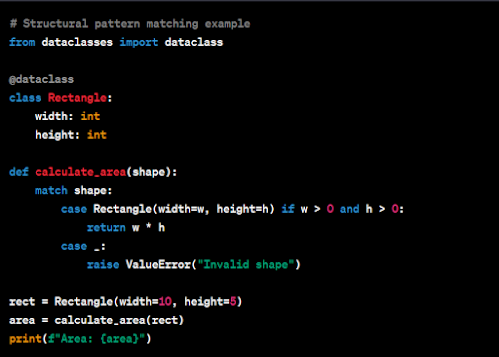Exploring Exciting New Features in Python for Beginner Developers in 2023
Introduction:
Python, the beloved programming language known
for its simplicity and versatility, continues to evolve and thrive. As a
beginner developer, it's essential to stay updated with the latest advancements
in Python. In this blog post, we'll dive into the exciting new features
introduced in Python in 2023. From enhanced syntax to improved performance,
these additions will empower you to write cleaner, more efficient code. So,
let's embark on this journey of discovery and explore the future of Python!
Section 1:
Pattern Matching for Easier Data
Extraction
Python 3.10 brings a game-changing feature
called pattern matching, which simplifies data extraction from complex
structures. With pattern matching, you can effortlessly unpack values, extract
data from nested objects, and even match specific patterns within sequences.
Let's take a look at a simple code example to illustrate its power:
# Pattern matching exampledata = {"name": "John", "age": 30, "address": {"street": "123 Main St.", "city": "New York"}} match data: case {"name": name, "address": {"city": city}}: print(f"Name: {name}, City: {city}") case {"age": age} if age < 18: print(f"Underage: {age}") case _: print("No match found")In
this example, we match the data
dictionary against specific patterns using the match
statement. If a pattern matches, the corresponding code block is executed. This
feature significantly simplifies conditional logic and enhances code
readability.
Section 2:
Structural Pattern
Matching for Clearer Code
Python 3.10 also introduces structural pattern
matching, which extends the power of pattern matching to more complex
scenarios. With structural pattern matching, you can match against custom data
structures, including classes and named tuples. Let's see it in action:
# Structural pattern matching examplefrom dataclasses import dataclass @dataclassclass Rectangle: width: int height: int def calculate_area(shape): match shape: case Rectangle(width=w, height=h) if w > 0 and h > 0: return w * h case _: raise ValueError("Invalid shape") rect = Rectangle(width=10, height=5)area = calculate_area(rect)print(f"Area: {area}")
Here,
we define a Rectangle class and use structural pattern
matching in the calculate_area function to handle different
shapes. By matching against the Rectangle
pattern and applying conditions, we ensure the validity of the shape and
calculate its area. This feature improves code clarity and eliminates the need
for complex nested conditionals.
Section 3:
Performance Boost with Just-in-Time Compilation
Python
3.9 introduced a new feature called Just-in-Time (JIT) compilation, which
enhances execution speed for certain operations. By leveraging the PyPy
interpreter, JIT compilation dynamically optimizes code at runtime, resulting
in faster execution. While CPython remains the default interpreter, the JIT
compiler offers a performance boost for computationally intensive tasks. Let's consider
an example:
# JIT compilation exampleimport math @jitdef calculate_square_root(n): return math.sqrt(n) result = calculate_square_root(25)print(f"Square root: {result}")
In this code snippet, the @jit
decorator signifies that the calculate_square_root
function should be compiled using the JIT compiler. This optimization can yield
significant performance improvements, particularly when executing repetitive
mathematical calculations.
Conclusion:
Python's newest
features, which will be available in 2023 provide exciting options for those
who are just beginning. Pattern matching is a simple method of data
extraction that enhances code readability and helps eliminate complex
conditionals that are nested. Structural pattern match-ups improve clarity
and permit matching against data structures that are custom. The
Just-in-Time compilation gives you a speed increase, which makes Python an
appropriate option for tasks that require a lot of computational power. By
integrating these capabilities into your programming arsenal it is possible to
write clean, efficient code while remaining at the forefront development Python
development.
Python's dedication
to continual improvement guarantees that the language stays useful and
effective. While you're on the Python journey, be sure you explore these
new features and take advantage of the potential of these features. Enjoy
your programming!
Keep in mind that
this blog entry is merely a peek into the latest features available in
Python. There's a vast world of possibilities awaiting your
exploration. Be curious, continue to learn, and revel in the endless
possibilities Python offers! with
Nearlearn offers the Best Python Course inBangalore to allow you to equip yourself with all the hottest skills. If you
want to continue hearing about the latest news and gain inspiration from
leading professionals in Python development, stay tuned to our blog and follow
us on Twitter.









